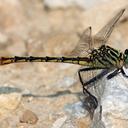United States and Canada
This species just reaches the easternmost edge of the region, where it is uncommon. It is slightly larger than the other two species in the genus. Its face is green with a prominent dark cross-stripe. The top of the frons is yellowish and the vertex black. The thorax is green with brown antehumeral and humeral stripes widely separated by a green stripe at least as wide as each of them. The mid- and third lateral thoracic stripes are both present and well-developed. The wings have yellowish-brown costa. The abdomen is greenish with an u ninterrupted dark stripe dorsolaterally on segments 3-6 and segments 7-9 are orange-brown and expanded laterally.
Size: Total length: 60-68 mm; abdomen: 46-52 mm; hindwing: 36-42 mm.
Similar Species (south-central US): Russet-tipped Clubtail (Stylurus plagiatus) has shorter legs with out prominent spines on the hind femur. Flag-tailed Spinyleg (D. spoliatus) is paler and smaller with pale rings on the middle abdominal segments. Black-shouldered Spinyleg (D. spinosus) has a broad black stripe on the shoulder.
Habitat: Small sluggish coastal streams with relatively low turbidity, mucky bottoms and emergent vegetation.
Natural History: Eastern Louisiana appears to be the western limit for this coastal species. Larvae have beenr reported from Iberia and Saint Tammany parishes, respectively. These are the only records of this species in the south-central United States.
Distribution: Southeastern U.S. from Florida to Louisiana.
Source: Abbott, J.C. 2006-2010. OdonataCentral: An online resource for the distribution and identification of Odonata. Available at OdonataCentral.
Edited by Drew Weber (9/24/2015).
